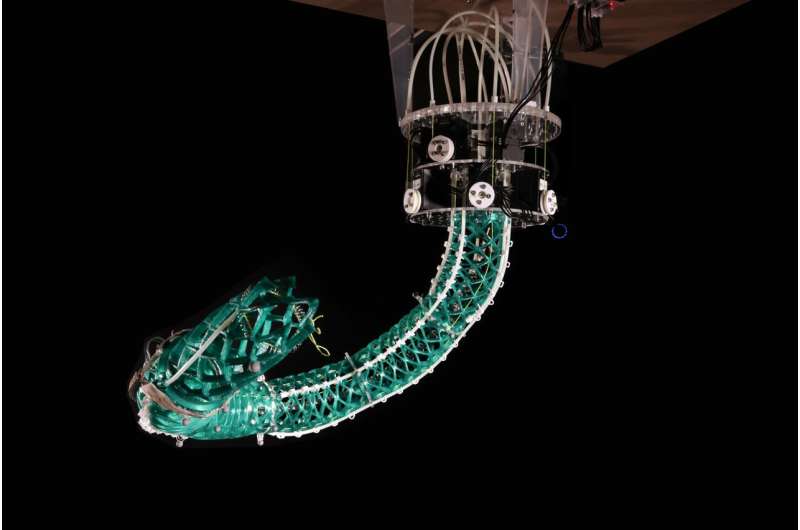This article has been reviewed according to Science X's editorial process and policies. Editors have highlighted the following attributes while ensuring the content's credibility:
fact-checked
trusted source
proofread
Introducing the trimmed helicoid, a soft robot arm that's based on an elephant's trunk

At EPFL's CREATE lab, under the guidance of Josie Hughes, a breakthrough has been made in the realm of soft robotics. Drawing inspiration from the versatile movement of elephant trunks and octopus tentacles, the team introduced the trimmed helicoid—a novel robotic structure that promises greater compliance and control in robotic designs.
With a blend of keen biological observation and computational modeling, the researchers have now unveiled the soft robot arm capable of intricate tasks, ensuring safer human-robot interactions. The findings, detailing both the structure and methodology, are a collaboration with the Department of Cognitive Robotics at TU Delft and were published in npj Robotics.
Professor Hughes stated, "Through the invention of a new architectured structure, the trimmed helicoid, we've designed a robot arm that excels in control, range of motion, and safety. When the novel architecture is combined with distributed actuation—where multiple actuators are placed throughout a structure or device—this robot arm has a vast range of motion, high precision, and is inherently safe for human interaction."
Whereas traditional robots are rigid, often making them unsuitable for delicate tasks or close human interactions, CREATE's soft robot arm is designed for safer interactions with humans and adaptability to a wider range of tasks. With an unprecedented combination of flexibility and precision, the soft and compliant nature of the arm reduces potential risks during human-robot interactions. This opens doors for its application in health care, elderly care, and more.
Unlike their rigid counterparts, the soft robot arm can adapt to different shapes and surfaces, making it an ideal tool for intricate tasks like picking fruits or handling fragile items. In industry, it might become the go-to solution for delicate assembly lines, working alongside humans, augmenting their capacity instead of replacing them. The agricultural industry could also benefit from its gentle touch in handling crops, accompanying workers to lessen their workload during intense harvesting periods.
The crux of the research lies in the robotic arm's novel architecture. The researchers have creatively modified a spring-like spiral, which they call a "helicoid," by trimming parts of it to give it diverse functionalities. This seemingly simple act has allowed them to precisely control how flexible or stiff the spiral becomes in different directions.
By adjusting its shape, they can make the inner part resistant to being squashed and the outer part flexible enough to bend easily. With this special design, they've created a soft robot that can move and act in ways previously unseen, showing the kind of dexterity and soft touch found in nature, like in an elephant's trunk or an octopus's tentacle.
"By observing these animals and developing a novel architectured structure, we aim to mimic this range of motion and control found in nature," Hughes noted. To do so, the team employed advanced computer modeling to turn observations into tangible results. Using these models, they iteratively tested their innovative spiral designs—into a final trimmed helicoid shape.
Qinghua Guan and Francesco Stella, who spearheaded the actual creation of the robot, gave insights into the design and optimization process. "We introduce a specific surface into the computer model, then trim and adjust. Computational methods guide us, helping assess the optimal geometric structure for maximum workspace and compliance."
The result? A robotic creation, drawing from nature, but refined with precise human ingenuity and computer modeling. "In the end, our computer models were accurate to the point where we only had to build one version of the arm."
The advancements at EPFL's CREATE lab symbolize a pivotal shift in the robotics field. Traditional robotic applications, dominated by rigid mechanics, could see a shift towards this softer, more human-friendly counterpart. A patent has been filed for this first commercial soft manipulator, and a EPFL and TU Delft joint start-up has been launched under the name Helix Robotics.
As Hughes aptly summarized, "Merging keen observations from nature with precise computational modeling has unveiled the potential of soft robotics for future commercial applications. As we move forward, our aim is to bring robots closer to humans, not just in proximity but in understanding and collaboration. We hope that this soft robotic arm exemplifies a future where machines assist, complement, and understand human needs more deeply than ever before."
More information: Qinghua Guan et al, Trimmed helicoids: an architectured soft structure yielding soft robots with high precision, large workspace, and compliant interactions, npj Robotics (2023). DOI: 10.1038/s44182-023-00004-7


















